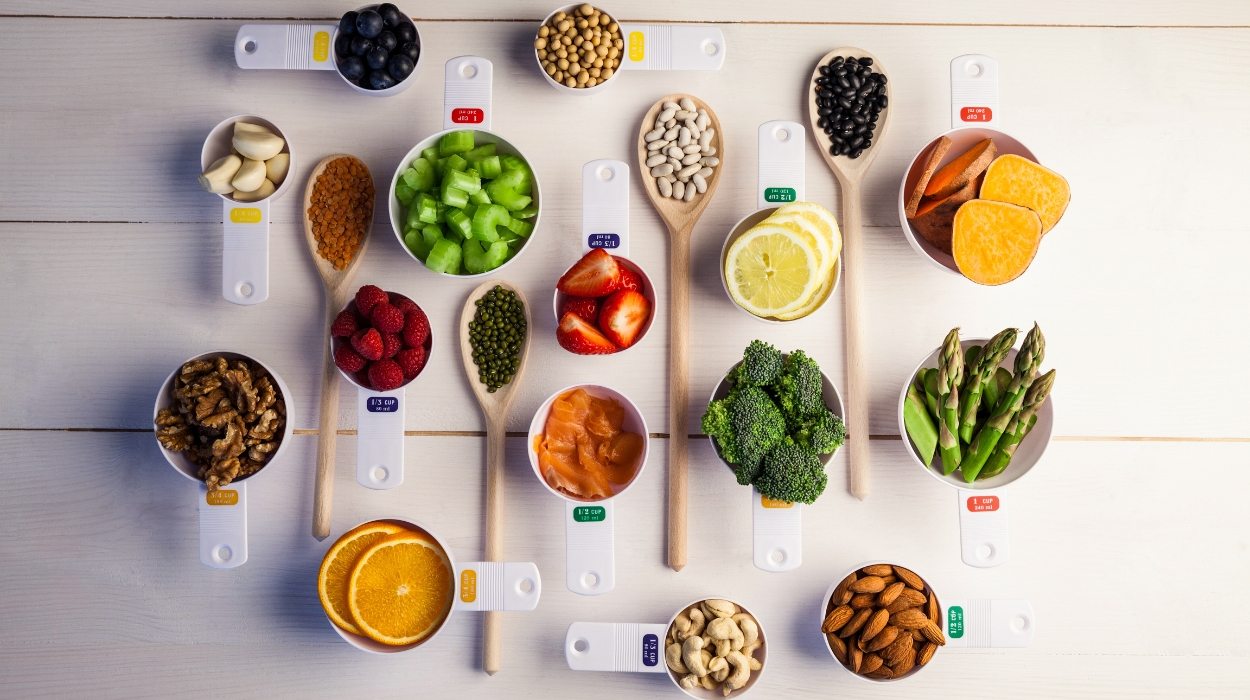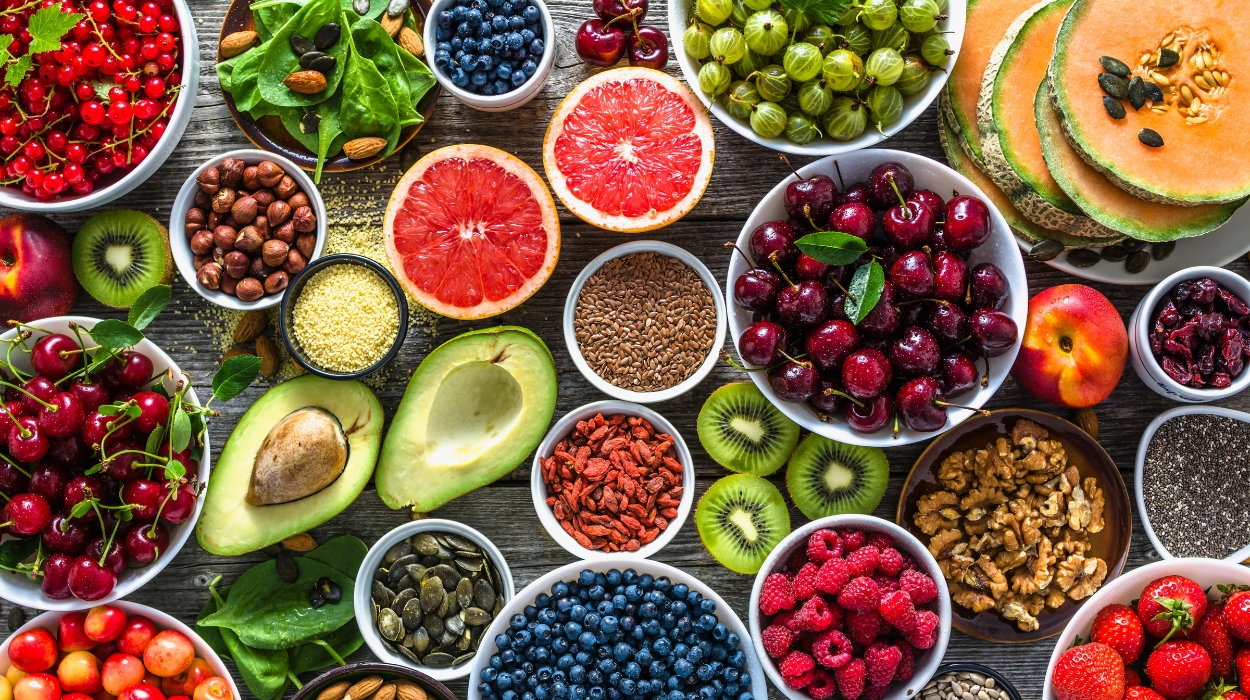 Expert's opinion
Expert's opinion
Expert's opinion
The article is a subjective view on this topic written by writers specializing in medical writing.
It may reflect on a personal journey surrounding struggles with an illness or medical condition, involve product comparisons, diet considerations, or other health-related opinions.
Although the view is entirely that of the writer, it is based on academic experiences and scientific research they have conducted; it is fact-checked by a team of degreed medical experts, and validated by sources attached to the article.
The numbers in parenthesis (1,2,3) will take you to clickable links to related scientific papers.
Portion Control For Weight Loss: Tips To Measure Portion Sizes 2024

Most people know that what we eat[1] can play a major role in determining the size of our waistline. But did you know that how much we eat at every meal — and how often we sit down to eat — can play a major defining role in our fat loss success, too? The truth is, we now know that portion control for weight loss really works, especially if we choose nutrient-rich superfoods and avoid ultra-processed alternatives. But it’s not always easy to follow a portion control diet (after all, our favorite snacks can be so tempting!).
That’s why this article will share the science[2] behind effective portion control to help you blast through your diet goals in order to reach and maintain your healthiest weight yet. Also, we’ll be sharing our most useful tips on managing portion sizes so that you can lower body fat and feel healthier and happier. Combined, these effective tips will help you lower body fat, power energy levels up, and barrel toward your weight loss goals faster!
6 Simple Tips On Portion Control For Weight Loss
- Choose Superfoods Over Sugars
- Focus On Chewing Quality
- Don’t Supersize Your Plate!
- Stay Hydrated And Drink Water
- Eat Breakfast
- Eat More Often!
6 Effective Tips On How To Portion Control For Weight Loss
The key to eating right is choosing foods that will fill you up, taste good, and contain a low number of calories. You’ll need to think about eating less but having more frequent meals (which is fun, as you’ll never be too far, time-wise, from your next meal!). Staying hydrated and switching up your cutlery and plates for smaller versions can also help you stay on track. Read on to find out more!
Choose Superfoods Over Sugars

Research shows a direct link[3] between consuming ultra-processed fatty and sugary energy-dense foods and the onset of obesity and fat gain. Conversely, eating superfoods (i.e., high-nutrient and antioxidant-packed, low-calorie mostly plant-based foods), can play a powerful role in your losing weight. Superfoods include foods like vegetables, whole grains, seeds, quinoa, berries, salmon, soy, and Brazil nuts. Opt for a wide range of them, and you will increase feelings of satiety at every meal, largely owing to their low glycemic index[4] (the rate at which energy is released from food).
Even better, high-fiber options[5] like leafy green kale can improve digestion. At the same time, the naturally high-protein[6] and healthy fat[7] content of superfoods like nuts and salmon will keep you feeling fuller for longer. And because of most superfoods’ low-calorie content, you can often really load up your plate!
Superfoods[8] are also widely observed to reduce the risk of degenerative diseases and to provide a dense source of antioxidants, vitamins, minerals, fiber, and other nutrients. If you’re struggling with incorporating them immediately into your well-balanced meal plans, a great strategy can be to prepare a small green salad as an appetizer. This will immediately increase your fiber intake, helping you to feel more satiated.[9]
Focus On Chewing Quality
The speed at which you consume your food is considered one of the most important factors to consider in managing and preventing obesity. Ultimately, eating slowly lets you enjoy your food a lot more. You’ll also feel more satiated, and you’re more likely to experience a lower body mass index[10] in the long term.
Don’t Supersize Your Plate!
There is evidence of the benefits of using smaller plates,[11] bowls, and serving instruments over a larger plate regarding portion control for weight loss. For example, a study of the impact of plate size and portion control plates on children’s food choices reported that children ate more food when given adult-sized plates.
Stay Hydrated And Drink Water

Drinking a glass of water before every meal can help moderate weight loss by enabling us to remain adequately hydrated. A recent obesity study reported a significant association between inadequate hydration,[12] an elevated body mass index, and the presence of obesity.
Eat Breakfast
Skipping breakfast[13] has been found in many studies to contribute to obesity. So don’t deny yourself — just make sure you’re choosing great, healthy choices, like an egg white omelet with kale and tomatoes pan-fried on whole grain brown toast. That way, you’ll consume fewer calories than with high-sugar cereal options, still feel full, and even benefit from a lower likelihood of weight gain in the future!
Eat More Often!
Here’s the best news for anyone who doesn’t love to diet. Studies of meal frequency show that doubling your meal frequency[14] (from the traditional three to six meals per day) is statistically significant relative to weight loss. It also notably improves glycemic control which means that your blood sugar levels are more balanced, and you’ll be less likely to experience hunger as a response to hypoglycemia.[15]
Finally, if you’d like to focus on a more structured approach to achieve weight loss and practice mindful eating, you can also check out a range of diets for more help and guidance.
What Is Portion Control?
To quote the Cambridge Dictionary, portion control is ‘the process of making sure that the amount of food you eat for each meal is not too large, especially when you are trying to lose weight.
In other words, it reflects our ability to eat a yummy breakfast, nutritious lunch, or indulgent dinner that meets our energy needs without providing extra calories. But exactly why is it so important?
Why Is Portion Control Important?
Portion size is certainly important for our health, with a wide body of evidence[16] reflecting its many positive impacts on obesity, body mass index, and general health. Choosing a portion size that is way too big has been linked directly, for example, to being overweight and obese, both of which are associated with many chronic diseases.[17]
Specifically, trying to eat smaller portions more frequently can help to keep our blood sugar levels from falling (which can help in the management of type 2 diabetes[18] as well as hunger levels), as it will make us less likely to crave calorie-dense, high-energy, sugary snacks.
And finally, managing our proper portions and serving sizes will reduce our overall calorie intake. The tendency for supermarkets and restaurants to supersize their portions has been linked directly to a growing obesity crisis, so preparing food at home[19] (rather than buying takeout or visiting a restaurant) can help us avoid excess, unneeded calories.
Looking for a boost to your metabolic rate and your overall fat loss? Consider using one of the best fat burners on the market for a little extra assistance.
How Can Portion Control Help You Lose Weight?
Overall calorie consumption per day is not the only decisive factor in how many calories we eat are stored as fat or used for energy. How we divide those calories into separate meals can be important, too. For example, while a healthy diet can help you shed body fat, portion control-focused strategies[20] (such as using smaller plates and chewing more when eating) can significantly mediate the overall number of calories that you ingest from a portion of food, and help you achieve dieting goals more effectively.
Interestingly, the portion size effect,[21] or PSE, explains how people are automatically likely to over-consume when served larger portions (one reason why eating out can be problematic when we are on a diet). We also know that when we consistently eat portions that are too large for our energy intake needs, we will gain body fat.[22] Studies show this relationship between obesity and portion size generally holds[23] across food groups, body types, and age ranges. So it’s pretty clear that if we want to lose weight, we must focus on how much we eat at each meal.
But here’s the problem. It sure is easy enough to talk a mean game about saying no to that second slice of pizza, but a lot harder to follow through.
So that’s exactly why we’ve corralled the most effective strategies to control portions to help you out above!
The Bottom Line
It’s worth remembering that effective portion control doesn’t only happen when we sit down to eat. A great night’s sleep will help to regulate the hormones ghrelin and leptin[24] (the night before), which play a huge role in regulating appetite (the morning after!). After all, research shows that even one night of disrupted sleep[25] can make mastering portion control much tougher. That means that prioritizing sleep hygiene should be a major goal for anyone hoping to lose body fat.
Regular physical activity has also been proven to regulate appetite.[26] So building in a brisk morning walk, gym session, or bike ride to your day might just provide the appetite-busting boost you need to stay on track!
The bottom line is this. Portion control might be easy to grasp, but it is a lot harder for most of us to achieve. And that’s because food is one of the greatest pleasures in life. But by relying on the tips and tricks we’ve covered in this article, you shouldn’t need to deny yourself those pleasures. The key is to eat smart, eat small frequent meals, and simply enjoy the many benefits of healthy eating.
+ 26 sources
Health Canal avoids using tertiary references. We have strict sourcing guidelines and rely on peer-reviewed studies, academic researches from medical associations and institutions. To ensure the accuracy of articles in Health Canal, you can read more about the editorial process here
- Estruch, R. and Ros, E. (2020). The role of the Mediterranean diet on weight loss and obesity-related diseases. Reviews in endocrine and metabolic disorders, [online] 21(3), pp.315–327. doi:https://doi.org/10.1007/s11154-020-09579-0.
- Wadden, T.A., Jena Shaw Tronieri and Butryn, M.L. (2020). Lifestyle modification approaches for the treatment of obesity in adults. American Psychologist, [online] 75(2), pp.235–251. doi:https://doi.org/10.1037/amp0000517.
- Costa, C., Rauber, F., Paula, Caroline Nicola Sangalli, Dal, P. and Márcia Regina Vitolo (2019). Ultra-processed food consumption and its effects on anthropometric and glucose profile: A longitudinal study during childhood. Nutrition Metabolism and Cardiovascular Diseases, [online] 29(2), pp.177–184. doi:https://doi.org/10.1016/j.numecd.2018.11.003.
- Maria, S., Addison, E., Medeiros, G. and Teixeira, E. (2014). Effect of low Glycaemic Index Diets on Satiety. [online] ResearchGate. Available at: https://www.researchgate.net/publication/265736185_Effect_of_low_Glycaemic_Index_Diets_on_Satiety.
- Bordenave, N., Lamothe, L. and Kale, M.S. (2020). Dietary Fibers in Foods – Formulating and Processing for Nutritional Benefits. Food engineering series, [online] pp.437–457. doi:https://doi.org/10.1007/978-3-030-38654-2_19.
- Jia Jiet Lim, Liu, Y., Lu, L., Daniel Bunout Barnett, Sequeira, I.R. and Poppitt, S.D. (2022). Does a Higher Protein Diet Promote Satiety and Weight Loss Independent of Carbohydrate Content? An 8-Week Low-Energy Diet (LED) Intervention. Nutrients, [online] 14(3), pp.538–538. doi:https://doi.org/10.3390/nu14030538.
- Paulo, José Ángel Pérez-Álvarez, Pateiro, M., Viuda-Matos, M., Fernández-López, J. and Lorenzo, J.M. (2021). Satiety from healthier and functional foods. Trends in Food Science and Technology, [online] 113, pp.397–410. doi:https://doi.org/10.1016/j.tifs.2021.05.025.
- Gupta, E. and Mishra, P. (2020). Functional Food with some Health Benefits are so Called as Superfood-A Review. [online] ResearchGate. Available at: https://www.researchgate.net/publication/343034809_Functional_Food_with_some_Health_Benefits_are_so_Called_as_Superfood-A_Review.
- Cruz-Requena, M., Cristbal AguilarGonzlez, Barragn, L. and Herrera, R. (2016). Dietary fiber: An ingredient against obesity. [online] ResearchGate. Available at: https://www.researchgate.net/publication/301738749_Dietary_fiber_An_ingredient_against_obesity.
- Chamorro, R., Garrido, M., Algarín, C., Lozoff, B. and Peirano, P. (2023). A single night of moderate at-home sleep restriction increases hunger and food intake in overweight young adults. Nutrition, [online] 108, pp.111962–111962. doi:https://doi.org/10.1016/j.nut.2022.111962.
- Hollands, G.J., Shemilt, I., Marteau, T.M., Jebb, S.A., Lewis, H., Wei, Y., Higgins, J.P.T. and Ogilvie, D. (2015). Portion, package or tableware size for changing selection and consumption of food, alcohol and tobacco. The Cochrane library, [online] 2018(11). doi:https://doi.org/10.1002/14651858.cd011045.pub2.
- Chang, T., Ravi, N.S., Plegue, M., Sonneville, K.R. and Davis, M.M. (2016). Inadequate Hydration, BMI, and Obesity Among US Adults: NHANES 2009-2012. Annals of Family Medicine, [online] 14(4), pp.320–324. doi:https://doi.org/10.1370/afm.1951.
- Watanabe, Y., Saito, I., Ikuyo Henmi, Yoshimura, K., Maruyama, K., Yamauchi, K., Matsuo, T., Kato, T., Tanigawa, T., Kishida, T. and Asada, Y. (2014). Skipping Breakfast is Correlated with Obesity. Journal of Rural Medicine, [online] 9(2), pp.51–58. doi:https://doi.org/10.2185/jrm.2887.
- Salehi, M., Kazemi, A. and Jafar Hasan Zadeh (2014). The Effects of 6 Isocaloric Meals Pattern on Blood Lipid Profile, Glucose, Hemoglobin A1c, Insulin and Malondialdehyde in Type 2 Diabetic Patients: A Randomized Clinical Trial. Iranian Journal of Medical Sciences, [online] 39(5), p.433. Available at: https://www.ncbi.nlm.nih.gov/pmc/articles/PMC4164890/.
- Current Medical Research and Opinion. (2014). Hypoglycemia, its implications in clinical practice, and possible ways to prevent it. [online] Available at: https://www.tandfonline.com/doi/full/10.1185/03007995.2014.890096.
- Almiron-Roig, E., Forde, C.G., Hollands, G.J., Vargas, M. and Jeffrey Michael Brunstrom (2019). A review of evidence supporting current strategies, challenges, and opportunities to reduce portion sizes. Nutrition Reviews, [online] 78(2), pp.91–114. doi:https://doi.org/10.1093/nutrit/nuz047.
- Emanuele Di Angelantonio, Bhupathiraju, S.N., Wormser, D., Gao, P., Kaptoge, S., Berrington, A., Cairns, B.J., Huxley, R.R., Jackson, C.L., Joshy, G., Lewington, S., Manson, J.E., Murphy, N., Patel, A.V., Samet, J.M., Woodward, M., Wang, Z., Zhou, M., Bansal, N. and Barricarte, A. (2016). Body-mass index and all-cause mortality: individual-participant-data meta-analysis of 239 prospective studies in four continents. The Lancet, [online] 388(10046), pp.776–786. doi:https://doi.org/10.1016/s0140-6736(16)30175-1.
- Evert, A.B., Boucher, J.L., Cypress, M. and Yancy, W.S. (2013). Nutrition Therapy Recommendations for the Management of Adults With Diabetes. [online] ResearchGate. Available at: https://www.researchgate.net/publication/257598371_Nutrition_Therapy_Recommendations_for_the_Management_of_Adults_With_Diabetes.
- McGeown, L. (2019). The calorie counter-intuitive effect of restaurant menu calorie labelling. Canadian Journal of Public Health-revue Canadienne De Sante Publique, [online] 110(6), pp.816–820. doi:https://doi.org/10.17269/s41997-019-00183-7.
- Vargas-Alvarez, M.A., Navas-Carretero, S., Palla, L., J. Alfredo Martinez and Almiron-Roig, E. (2021). Impact of Portion Control Tools on Portion Size Awareness, Choice and Intake: Systematic Review and Meta-Analysis. Nutrients, [online] 13(6), pp.1978–1978. doi:https://doi.org/10.3390/nu13061978.
- C. Peter Herman, Polivy, J., Pliner, P. and Vartanian, L.R. (2015). Mechanisms underlying the portion-size effect. Physiology & Behavior, [online] 144, pp.129–136. doi:https://doi.org/10.1016/j.physbeh.2015.03.025.
- Livingstone, B. and L. Kirsty Pourshahidi (2014). Portion Size and Obesity. Advances in Nutrition, [online] 5(6), pp.829–834. doi:https://doi.org/10.3945/an.114.007104.
- Critical Reviews in Food Science and Nutrition. (2015). Portion Size: What We Know and What We Need to Know. [online] Available at: https://www.tandfonline.com/doi/full/10.1080/10408398.2012.679980.
- Brinkman, J.E., Reddy, V. and Sharma, S. (2023). Physiology of Sleep. [online] Nih.gov. Available at: https://www.ncbi.nlm.nih.gov/books/NBK482512/.
- Chamorro, R., Garrido, M., Algarín, C., Lozoff, B. and Peirano, P. (2023). A single night of moderate at-home sleep restriction increases hunger and food intake in overweight young adults. Nutrition, [online] 108, pp.111962–111962. doi:https://doi.org/10.1016/j.nut.2022.111962.
- Hazell, T.J., Islam, H., Townsend, L.K., Schmale, M.S. and Copeland, J.L. (2016). Effects of exercise intensity on plasma concentrations of appetite-regulating hormones: Potential mechanisms. Appetite, [online] 98, pp.80–88. doi:https://doi.org/10.1016/j.appet.2015.12.016.



